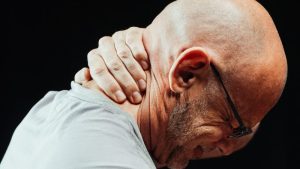 SPINAL PAIN
SPINAL PAIN
Most patients find themselves having pain in the neck, the cervical region, or having pain in the lower back region, or the lumbar region. These are the most prevalent sites of deterioration and stress on the spinal cord that could possibly cause compression, deterioration, and severe pain. At Global Ortho and Spine, we offer treatment to patients experiencing a range of conditions including those with:
- Back Pain
- Herniated Disc
- Degenerative Disc
- Spinal Stenosis
- SI Joint Dysfunction
- Sciatica
- Pinched Nerve
- Neck Pain
- Hip Pain
- Joint Pain
- Bulging Disc
- Slipped Disc
- Scoliosis
- Facet Disease
- Bone Spurs
- Kyphosis
- Spondylolisthesis
DORSAL PROCEDURES
Dr. Slaughter uses the latest medical technology with the state of art medical facility to provide his patients with the best possible outcome. Click on the below tabs to know more about the services.
A herniated disc can irritate or press on nearby nerves, causing serious pain and discomfort. The surgery removes the impaired part of a disc in the spine, therefore easing pressure on the spinal cord. A Discectomy procedure can help treat pain that travels down the arms or legs from a compressed nerve.
A spinal fusion is completed to correct issues with the small bones in the spine, using a bone graft, and the overall goal is to fuse the painful vertebrae, healing into a single bone.
Some conditions can cause pain due to the vertebrae compressing or collapsing. Kyphoplasty is a procedure where medical-grade cement is injected into vertebrae using of a balloon device, restoring the vertebra’s height and relieving pain.
CERVICAL PROCEDURES
Dr. Slaughter uses the latest medical technology with the state of art medical facility to provide his patients with the best possible outcome. Click on the below tabs to know more about the services.
Cervical Arthroplasty is a joint replacement procedure that inserts a cervical artificial disc into the intervertebral space once the natural cervical disc has been removed. A cervical artificial disc is a prosthetic designed to maintain motion in the affected vertebral segment.
A Corpectomy is a surgical procedure where the vertebral bone and the intervertebral disc material are removed. The procedure is performed to relieve pain caused by strain on the spinal cord and spinal nerves.
A Cervical Discectomy is performed to treat and remove cervical disc material, causing the compressed nerve or spinal cord to bulge. When the cervical spinal cord is compressed, the patient can exhibit symptoms of weakness in the hand and lower limbs. Once the disc is removed, a space between the vertebrae is empty, relieving pressure from pinched nerve roots.
Laminoplasty is a surgical procedure for treating spinal stenosis by relieving pressure on the spinal cord. Widening the spinal canal can provide relief to patients with numbness, pain, or weakness.
A posterior cervical laminectomy and fusion is a procedure used to decompress and stabilize the cervical spine. This procedure can relieve pain, weakness, and numbness caused by spinal stenosis, a condition that causes narrowing of the spinal canal. Fusion involves using a bone graft to stimulate the bone to heal and fuse solid. Instrumentation, including medical implants and devices, provides spinal stabilization immediately and helps eliminate micro-motion that can interfere with fusion success.
LUMBAR PROCEDURES
Dr. Slaughter uses the latest medical technology with the state of art medical facility to provide his patients with the best possible outcome. Click on the below tabs to know more about the services.
The Coflex Interlaminar Stabilization procedure is used to treat moderate to severe spinal stenosis, using a single-piece titanium implant that goes in the back of your spine. The implant supports and preserves lumbar motion while relieving leg and back pain with immediate symptom relief in many patients.
Endoscopic discectomy is a less invasive and effective technique for treating patients with spinal herniated discs. Surgeons can see the spine with a camera, through a small surgical port, to remove herniated disc material that puts stress on the spinal cord.
Conditions like osteoporosis can cause the vertebrae to compress or even collapse, causing severe pain. During a Kyphoplasty procedure, a medical-grade cement is injected into vertebrae using a balloon-like device. The goal is to restore a vertebra’s height and possibly relieve pain.
Lateral interbody fusion treats pain caused by disc problems in the low back. Two or more bones of the spine are joined to alleviate pain, decompress nerves, and possibly correct scoliosis. The disc is removed, through a small incision on the side of the waist, and a bone graft is inserted to restore the height and relieve nerve pinching. During the healing process, the goal is for the bones to fuse into one solid piece.
Discs between the vertebrae cushion them, allowing the vertebrae to rotate and move seamlessly without the bones rubbing against each other. This procedure involves degenerated or worn disc with an artificial one made of metal or a combination of metal and plastic.
A herniated disc can irritate or press on nearby nerves, causing serious pain and discomfort. The surgery removes the impaired part of a disc in the spine, therefore easing pressure on the spinal cord. Discectomy work best for treating pain that travels down the arms or legs from a compressed nerve.
A Lumbar Discectomy is performed to treat and remove disc material that bulges to compress the nerve or the spinal cord. When the spinal cord is compressed, the most common complaint is weakness in the hand and lower limbs After the disc is removed, a space between the vertebrae is empty, relieving pressure from pinched nerve roots.
A laminectomy, also known as decompression surgery, is typically performed to alleviate pain caused by spinal stenosis or stress to the spine by creating space by removing a portion of the lamina.
The goal of the procedure is to restore spinal stability, by removing disc material and inserting a bone graft into the disc space. The surrounding spinal structure acts as a bridge for the bone to grow. Screws and rods are inserted to stabilize the spine while the treated area heals, and with time fusion occurs.
Spinal fusion is performed to join two or more bones of the spine, called vertebrae, eliminating movement between them. The spinal disc between the two vertebrae is removed and replaced with a cage-like structure. It can be constructed out of bone allograft or other synthetic material.
The sacroiliac joint is located in the pelvis and links the iliac bones to the sacrum. It plays an essential role in shock absorption to prevent impact forces from reaching the spine. Instability in the pelvis and lower back, which may cause pain or difficulty when standing, walking, or sitting. A bone graft and instruments are used to support bone growth over the SI joint and create one unit.
Spondylolisthesis happens when a bone in the spine slips forward, out of place. Patients often have symptoms of nerve compression, causing chronic back pain. The fusion process is followed by fixation which involves fitting metallic screws, rods, plates, or cages to stabilize the vertebrae, help in preventing continued slippage, and accelerate bone fusion.
A Transforaminal Lumbar Interbody Fusion is a particular type of fusion that joins the bones of the spine together. This is achieved using a bone graft or from elsewhere in the patient's body.
AUTO ACCIDENT/WORK-RELATED INJURIES
 At Global Ortho & Spine, we specialize and treat patients who have sustained injuries from an auto accident, a slip and fall, or a work-related incident. Patients are often in need of interventional treatment for injuries affecting the spinal region.
At Global Ortho & Spine, we specialize and treat patients who have sustained injuries from an auto accident, a slip and fall, or a work-related incident. Patients are often in need of interventional treatment for injuries affecting the spinal region.
Dr. Slaughter and the Global Ortho staff work to ensure that patients receive the correct treatment needed for their injuries. Managing personal injury or workers’ compensation spinal injury cases requires special knowledge of how to navigate the process. Our coordinators have the compassion and skill required for the job. Our close working relationships with case managers and insurance adjusters give our patients peace of mind and enable them to focus on their recovery.
Our commitment is to deliver compassionate care, through our exceptional surgeon and medical staff, who are highly experienced in restoring the quality of life for our patients. We strive for a quick recovery, and most importantly, a more pain-free life.
What to Expect during your visit:
- Medical Evaluation (IME: Independent Medical Exam)
- Knowledgeable Staff to Answer Questions and Provide Guidance
- Off Work / Work Restriction Letter as Needed
- Referral to Specialist: Neurologist, Pain Management
Whether you were injured in an automobile accident, hurt at work, or s have pain, Global Ortho & Spine will help restore your quality of life. For an appointment or to answer additional questions, call:
(800) 735-1178
 SPINAL PAIN
SPINAL PAIN At Global Ortho & Spine, we specialize and treat patients who have sustained injuries from an auto accident, a slip and fall, or a work-related incident. Patients are often in need of interventional treatment for injuries affecting the spinal region.
At Global Ortho & Spine, we specialize and treat patients who have sustained injuries from an auto accident, a slip and fall, or a work-related incident. Patients are often in need of interventional treatment for injuries affecting the spinal region.